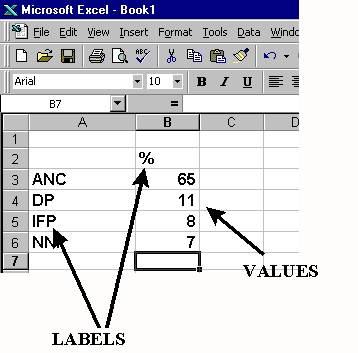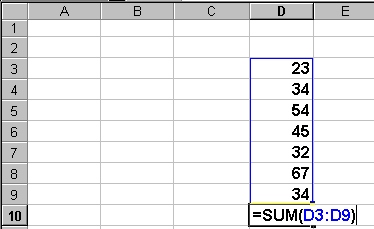Labels
and values
The entering of data into a spreadsheet
is just like word processing, but you have to first click
on the cell in which you want the data to be placed before
typing the data.
All words describing the values
(numbers) which you enter are called labels. The
numbers which you enter, and which can later be used
in formula's, are called values.
Notice also that the labels are all left
justified and the values are all right justified in their
cells.

Simple
Formula:
Place the cursor in the cell in which
you want the answer (result of the formula) to appear, and
press Enter once you have typed
the formula
All formula's start with an =
sign
Refer to the cell address instead of the value in the cell
e.g. =A2+C2 instead of
45+57
| + means
add |
e.g. A2+C2 |
add the value (number)
in A2 to the value (number) in C2 |
| - means subtract |
e.g. A2-C2 |
subtract the value (number) in C2
from the value (number) in A2 |
| * means multiply |
e.g. A2*4 |
multiply the value (number) in A2
by 4 |
| / means divide
|
e.g. A2/3 |
divide the value (number) in A2 by
3 |
Use BODMAS
i.e. Brackets first, then Division,
Multiplication, Addition
and Subtraction
e.g. =((A2-B2)*3)-100
Notice that individual sums within a sum
are bracketed and appear at the beginning of the formula.
Range
Formulae
These formula's are used for working with
long lists of numbers. A typical range formula looks like
this:
=SUM(A3:A30)
SUM is a function, meaning that it sums
(adds up) the list of numbers
The list of numbers is indicated in brackets.
The address of the first cell in the list is A3.
A colon : separates this cell address from
the last cell in the list, which is A30
=SUM(D3.D9)
Adds list of values from cell D3 to cell D9

=AVERAGE(D3:D9)
Averages the values from cell D3 to cell D9

Note: a short cut would be to select the column of figures, and an empty cell for the total, andthen to click on the sum icon  .
.
Other
range functions:
There are many formula functions that
you could explore with time. As an educator you are most
likely to use SUM and AVERAGE. Here are just a few more:
| SUM |
adds the numbers
in the list |
| AVERAGE |
averages the numbers
in the list |
| PRODUCT |
multiplies the
numbers in the list |
| MAX |
identifies the
highest number in the list |
| MIN |
identifies the
lowest number in the list |
| COUNT |
counts the number
of numerical items in the list |
| COUNTA |
counts the number
of alphabetical items in the list |
| COUNTIF |
counts the number
of items that satisfy certain criteria
e.g. =COUNTIF(A4:A20,">50") counts
the number of values that are higher than 50 in the
list from A4 to A20 - notice the use of the comma and
quotation marks to separate the list (A4:A20) from the
criteria (>50). |
Notice that you must have selected
an empty cell before typing the formula. The answer will
then appear in that cell.
Absolute values in a formula
When you copy a formula like =B5/B2
from Row 5 to Row 6, the values of the rows
(5 and 2) in the formula change automatically, so that it
would then be =B6/B3
Similarly if you copy =B5/B2 from
Column B to Column C, the values of the column
(B) in the formula change to C5/C2
If you want to prevent this column or
row change from happening, you should place a $ sign
in front of the row or columns indicator.
e.g. If you want B2 to remain unchanged,
the formula should be written as =B5/$B$2
i.e. neither B nor 2 must
change as the formula is copied.